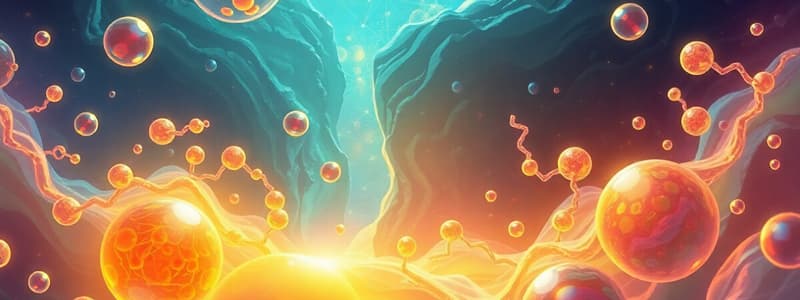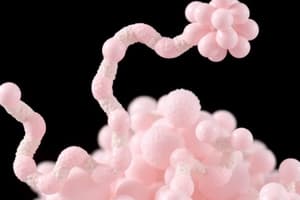Podcast
Questions and Answers
What is the primary role of enzymes in a chemical reaction?
What is the primary role of enzymes in a chemical reaction?
Which model describes the active site of an enzyme as having a rigid and fixed shape?
Which model describes the active site of an enzyme as having a rigid and fixed shape?
What occurs when the substrate binds to the active site of the enzyme according to the induced-fit model?
What occurs when the substrate binds to the active site of the enzyme according to the induced-fit model?
Which statement about enzymes is accurate?
Which statement about enzymes is accurate?
Signup and view all the answers
What happens to the reaction velocity when substrate concentration is greater than Km?
What happens to the reaction velocity when substrate concentration is greater than Km?
Signup and view all the answers
What does the 'T' state refer to in enzymatic reactions?
What does the 'T' state refer to in enzymatic reactions?
Signup and view all the answers
What is the significance of the catalytic site in enzyme functionality?
What is the significance of the catalytic site in enzyme functionality?
Signup and view all the answers
What does the Michaelis constant (Km) indicate about an enzyme's affinity for its substrate?
What does the Michaelis constant (Km) indicate about an enzyme's affinity for its substrate?
Signup and view all the answers
Which of the following statements about the activation energy (Ea) is correct?
Which of the following statements about the activation energy (Ea) is correct?
Signup and view all the answers
Which of the following factors does not affect the Michaelis constant (Km)?
Which of the following factors does not affect the Michaelis constant (Km)?
Signup and view all the answers
What is the relationship between enzyme concentration and Vmax?
What is the relationship between enzyme concentration and Vmax?
Signup and view all the answers
Why do enzymes not change the equilibrium of a reaction?
Why do enzymes not change the equilibrium of a reaction?
Signup and view all the answers
How does temperature affect enzyme-catalyzed reactions?
How does temperature affect enzyme-catalyzed reactions?
Signup and view all the answers
What is the significance of the maximal velocity (Vmax) in enzyme kinetics?
What is the significance of the maximal velocity (Vmax) in enzyme kinetics?
Signup and view all the answers
What type of plot is used to describe the relationship between reaction velocity and substrate concentration?
What type of plot is used to describe the relationship between reaction velocity and substrate concentration?
Signup and view all the answers
Which enzyme has a higher affinity for glucose based on the provided Km values?
Which enzyme has a higher affinity for glucose based on the provided Km values?
Signup and view all the answers
What is the effect of extreme pH on enzymes?
What is the effect of extreme pH on enzymes?
Signup and view all the answers
Which enzyme has an optimum pH of 2?
Which enzyme has an optimum pH of 2?
Signup and view all the answers
How do competitive inhibitors function?
How do competitive inhibitors function?
Signup and view all the answers
What is the role of statin drugs like atorvastatin?
What is the role of statin drugs like atorvastatin?
Signup and view all the answers
What characterizes a prosthetic group?
What characterizes a prosthetic group?
Signup and view all the answers
What defines the optimum pH for an enzyme's activity?
What defines the optimum pH for an enzyme's activity?
Signup and view all the answers
Which of the following is a characteristic of irreversible inhibitors?
Which of the following is a characteristic of irreversible inhibitors?
Signup and view all the answers
What happens to enzyme activity when temperature increases beyond the optimal range?
What happens to enzyme activity when temperature increases beyond the optimal range?
Signup and view all the answers
Study Notes
Enzyme Definition
- Enzymes are protein catalysts that speed up chemical reactions.
Enzyme Classification
- Oxidoreductases: Transfer of electrons (e.g., dehydrogenases, oxidases).
- Transferases: Group transfer reactions (e.g., transaminase, kinases).
- Hydrolases: Hydrolysis reactions (e.g., estrases, digestive enzymes).
- Lyases: Addition of groups to double bonds or formation of double bonds by removal of groups (e.g., phospho hexose isomerase, fumarase).
- Isomerases: Transfer of groups within molecules to yield isomeric forms (e.g., decarboxylases, aldolases).
- Ligases: Formation of C-C, C-S, C-O, and C-N bonds by condensation reactions coupled to ATP cleavage (e.g., citric acid synthetase).
Enzyme Specificity
- Substrate specificity: An enzyme's ability to react with only one substrate (e.g., lactase, urease, glucokinase).
- Reaction specificity: An enzyme is specific to a particular reaction, catalyzing only one type (e.g., pyruvate can undergo several reactions, each catalyzed by different enzymes).
- Stereo specificity: An enzyme is specific to one isomer (e.g., L-lactate dehydrogenase act on L-lactic acid, not D-lactic acid).
How Enzymes Lower Ea
- Molecules collide with each other, absorbing sufficient energy to overcome activation energy.
- Reactants convert to an activated condition (transition state).
- Reactants are converted into products.
- The rate of reaction increases
Meaning of Ea
- The energy difference between reactants and a high-energy intermediate (transition state).
- The transition state is formed during the conversion of reactant to product
Enzyme Function
- Enzymes provide catalytic groups that enhance the formation of the transition state.
- Enzymes stabilize the transition state and enhance product formation.
- Enzymes provide alternate reaction pathways by lowering activation energy, increasing reaction rate.
- Enzymes do not alter the free energy of reactants or products and do not change the equilibrium of the reaction.
- Enzymes have an active site where the reaction occurs.
- The active site has a binding site for the substrate.
- The substrate binds to the active site, and an enzyme-substrate complex (ES complex) is formed.
- The ES complex undergoes conformational change.
- The enzyme catalyzes the conversion of substrate to products.
- The resulting product is released, and the enzyme returns to its original form.
Lock and Key Model
- The active site of the enzyme has a fixed shape.
- The substrate must be completely complementary to the enzyme's active site shape.
Induced-fit Model
- The enzyme's active site is not initially fully complementary to the substrate's shape.
- The active site is flexible.
- When a substrate binds to the active site, the enzyme's conformation changes, allowing the substrate to fit precisely into the active site.
Properties of Enzyme
- Enzymes are reusable.
- Enzymes exhibit specificity, catalyzing specific reactions.
- Enzymes' catalytic activity can be regulated to control the rate of product formation.
- Enzymes are highly catalytically efficient.
Michaelis-Menten Kinetics
- The Michaelis-Menten equation describes how reaction velocity (V₀) changes with substrate concentration ([S]).
- V₀ = (Vmax [S]) / (Km + [S])
- Assumptions:
- Substrate concentration is much higher than enzyme concentration.
- Steady-state assumption: the concentration of enzyme-substrate complex (ES) remains constant over time.
- Initial velocity (V₀) is used in the analysis of enzyme reactions..
Factors affecting enzyme-catalyzed reactions: Substrate Concentration
- Michaelis-Menten plot is hyperbolic.
- Vmax is the maximum velocity of the reaction.
- Km represents the substrate concentration at which the reaction velocity is half of Vmax, reflecting enzyme affinity for substrate.
- When [S] is much less than Km, the reaction is first order, and velocity is directly proportional to [S].
- When [S] is much greater than Km, the reaction is zero-order, and velocity is independent of [S].
- Increasing enzyme concentration increases Vmax but does not affect Km.
Factors affecting enzyme catalysed reactions: Temperature
- Velocity increases with temperature up to a peak.
- Further increases cause denaturation resulting in decreased velocity.
- Graph is bell-shaped.
Factors affecting enzyme catalysed reactions: pH
- Each enzyme has an optimal pH for maximal activity.
- Extreme pH values can cause denaturation and change in active sites conformation.
- Graph is bell-shaped.
Cofactors
- Inorganic cofactors (metal ions): -Loosely associated (metal-activated enzyme) - Mg, Mn -Tightly associated (metalloenzymes)-Fe, Cu, Zn
- Organic cofactors (coenzymes): -Tightly associated (Riboflavin: FMN, FAD) -Loosely associated (Readily associate and dissociate) - Niacin, NAD, NADP, B5, Coenzyme A
Holoenzyme vs. Apoenzyme
- Holoenzyme: complete, active enzyme with its cofactor.
- Apoenzyme: the protein component of a holoenzyme without its cofactor
Prosthetic Groups vs. Co-substances
- Prosthetic groups: permanently associated with the enzyme.
- Co-substances: temporarily associated with the enzyme.
Coenzymes derived from B Vitamins
- Specific B vitamins serve as coenzymes for various reactions, including those involving the transfer of one-carbon groups, oxidation-reduction reactions, acyl group transfers, and carboxylation reactions.
Enzyme Inhibition
- Competitive inhibition: inhibitor binds to the active site, competing with the substrate.
- Non-competitive inhibition: inhibitor binds to a site other than the active site, changing the enzyme's shape and reducing activity.
- Suicide inhibition: inhibitor is a substrate that is modified by the enzyme to become an irreversible inhibitor.
Antibiotic Sulfanilamide inhibition
- Sulfanilamide is a structural analog of PABA (para-aminobenzoic acid), an intermediate in folic acid synthesis.
- Sulfanilamide competitively inhibits the enzyme that uses PABA, preventing bacterial growth.
Hypercholesterolemia
- Statin drugs inhibit HMG-CoA reductase, lowering cholesterol levels.
- Statins are structural analogs of HMG-CoA, the substrate.
- They compete with HMG-CoA for the active site.
Non-competitive inhibitor
- Non-competitive inhibitors bind to a site other than the active site.
- They change the shape of the enzyme, decreasing activity, with little or no effect on Km.
- The presence of an inhibitor reduces Vmax.
Suicide Inhibitor
- Suicide inhibitors have a structure similar to a substrate.
- The inhibitor is initially bound normally and becomes chemically modified by the enzyme and forms an irreversible inactivator complex.
- Irreversible inhibition.
Studying That Suits You
Use AI to generate personalized quizzes and flashcards to suit your learning preferences.
Related Documents
Description
This quiz explores the definition, classifications, and specificity of enzymes. Test your knowledge on the various types of enzymes such as oxidoreductases, transferases, and their roles in biochemical reactions. Understand key concepts related to enzyme mechanisms and substrate specificity.




